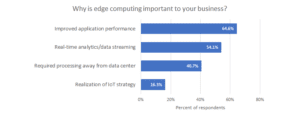Also see: Top Edge Computing Companies
According to MarketsandMarkets analysis, the edge computing market will be worth $6.72 billion by 2022. Edge computing allows customers the flexibility to have devices rely on the cloud, perform tasks on their own and talk to each other when it makes sense.
Futurum reported that nearly three-quarters (72.7%) of companies had already implemented an edge-computing strategy. Furthermore, almost all (93.3%) intended to invest in edge computing in the next 12 months. What were the key drivers of this enthusiasm for edge computing? For Futurum’s respondents, it was improved application performance, followed by real-time analytics/data streaming:
Data: Futurum Research / Chart: ZDNet
“The edge will become the next hybrid cloud target architecture as firms seek to act on their customers’ behalf using voice, image and video at scale,” Forrester analyst Brian Hopkins wrote in a recent report, “Trend: Cloud Strategies Shift Towards the Edge.” With ever more data being generated, processed and stored in ever more locations, issues surrounding infrastructure management and data security, privacy and governance will become even more important than they are today.
There are two ways to approach edge computing from a development perspective: serverless and containers. Containerization technologies, like Kubernetes and Docker, enable code portability, so organizations can deploy the same code to different locations. Serverless, such as Akamai EdgeWorkers, work in a similar fashion to function as a service (FaaS), which can be used for web application functions and power streaming content close to the user. Both approaches have their advantages and disadvantages. As a general rule, serverless is best suited for running applications in the public cloud and containers are useful in transforming on-premises hardware resources into a private cloud.
Containers
Containers offer a logical packaging mechanism in which applications can be abstracted from the environment in which they run. This decoupling allows them to be deployed easily and consistently, regardless of the target environment (private data center, the public cloud, or developer’s laptop). Large applications with a fairly constant, predictable workload will benefit from containers.
Pros:
- System and vendor agnostic
- Version control
- Isolated from the rest of the architecture
Cons:
- Orchestrating containers is difficult
- High costs
- Hard to get started
Serverless
Serverless works well for lightweight, flexible applications. Placing application functions close to end users reduces latency, improves costs and provides compliance with many existing privacy regulations.
Pros:
- Pay-per-execution
- Auto-scaling
- Fast time-to-market
Cons:
- Vendor lock-in
- Cold starts
- Complex applications are hard to build
Choose containers and container orchestrators when you need flexibility, or when you need to migrate legacy services. Choose serverless when you need speed of development, automatic scaling and significantly lowered runtime costs.
Per IDC research, by 2024 25% of organizations will look forward to using cases that integrate edge data with apps already hosted in the cloud.
2021 will also see a series of partnerships between traditional cloud and edge computing service providers. Watch telecom service providers have a key role in driving these hybrid ecosystems. Going forward, devices and applications closer to the consumer’s location will play an important role in the larger fabric of software development. Decide today what applications you will transition to container or serverless architecture at the edge.
